Posted by James (admin) on 15th July 2014
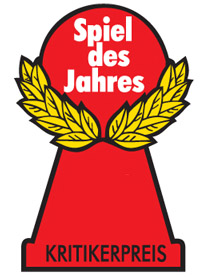 The winners of the Spiel des Jahres and the Kennerspiel des Jahres were announced yesterday. The winners were Camel Up and Istanbul. It’s always interesting to try and work out the winners because I know what I like the most (and would vote for) is definitely not the same as what I think will be voted for by the jury, because the SdJ awards are for a more general German game-playing audience (and not a more serious gamer audience).
The winners of the Spiel des Jahres and the Kennerspiel des Jahres were announced yesterday. The winners were Camel Up and Istanbul. It’s always interesting to try and work out the winners because I know what I like the most (and would vote for) is definitely not the same as what I think will be voted for by the jury, because the SdJ awards are for a more general German game-playing audience (and not a more serious gamer audience).
If it was my choice, it would have been Splendor for the main prize as it’s the one I enjoy the most; however, I guessed Camel Up would be picked as the winner as it’s a more accessible game for a wider audience and the card pyramid offers an appealing, physical element. So, Camel Up winning wasn’t a surprise to me.
The Kennerspiel was a hard one to call – I had it down to Istanbul and Rokoko. I really like Istanbul but I wondered if it was slightly too light for the Kennerspiel, even in the context of the SdJs. However, Rokoko was maybe too far the other way as it’s a tense game with a lot of elements to balance and time correctly. So, I was happy with either of those being the winner.
I thought this year’s SdJ was a good one as I found all the games to be good quality – whereas, some years I scratch my head wondering how some of the games were picked. In fact, it’s the first year I’ve found myself playing all the nominees, and playing some of them quite a lot. I still think Lewis & Clark should have been at least a recommendation though (if not a nominee) for the Kennerspiel.
Links to my reviews of all the SdJ nominees, winners and some recommendations are on my SdJ 2014 page.
James.
Tags: board game news, Board Games, board gaming, Camel Up, Concept, Concordia, Istanbul, Rokoko, SdJ, Spiel des Jahres, Splendor
Posted in Board Games, Camel Up, Concept, Concordia, Istanbul, Rokoko, Splendor, Thoughts On | No Comments »
Posted by James (admin) on 1st June 2014
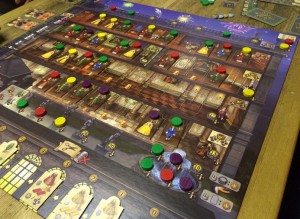 Rokoko is a euro-game about preparing for the ball at the Royal Palace. This may sound pretty light-weight but, do not be fooled, this is a euro-game with a lot of moving parts to work out, balance and combine – so it’s a game for gamers. It’s one of the games nominated for Spiel des Jahres Kennerspiel 2014 (the German complex game of the year).
Rokoko is a euro-game about preparing for the ball at the Royal Palace. This may sound pretty light-weight but, do not be fooled, this is a euro-game with a lot of moving parts to work out, balance and combine – so it’s a game for gamers. It’s one of the games nominated for Spiel des Jahres Kennerspiel 2014 (the German complex game of the year).
Players are aiming to earn the most Prestige Points (PPs) by the end of the game which is 7 rounds long when the ball takes place. Players each have cards which represent their tailors and, at the start of each round, players select 3 of their available tailors to use during that round. Players then take turns using one tailor to perform 1 action and they can also carry out any bonus shown on the tailor’s card too. Tailors are either apprentices, journeymen, or masters and some actions can not be performed by the less experienced tailors, i.e. only journeymen and masters can make dresses, and only masters can hire new tailors. Read the rest of this entry »
Tags: board game news, Board Games, board gaming, Eggertspiele, Essen, Pegasus Spiele, Rococo, Rokoko, SdJ, Spiel 13, Spiel 2013, Spiel des Jahres
Posted in Board Game Review, Board Games, Essen Spiel 13, Rokoko, Spiel 2013 | No Comments »
Posted by James (admin) on 28th May 2014
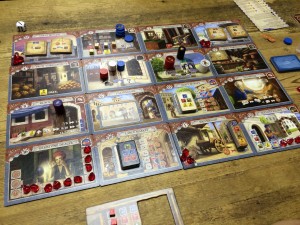
At the bottom of the photo, you can see a player’s hand cart which has yet to be upgraded. When it is, the upgrade tile fills-up part of the missing piece.
Istanbul is one of the games nominated for Spiel des Jahres Kennerspiel 2014 (the German complex game of the year) and is designed by Rüdiger Dorn who has designed a wealth of games. The game is a race to be the first to collect 5 gems with an interesting core game mechanic and a surprisingly dense amount of decision-making.
The board is made up of a 4×4 grid of locations (large tiles) and each player starts with a stack of wooden discs which are their merchant and assistants (with the merchant always on top). Players take turns moving their merchant (and any assistants currently underneath it) so they can use the actions of the location tiles. When a player moves to a location that does not contain one of their assistants, they remove an assistant from their stack, place it on the location, and then take the location’s action. When a player moves to a location that does contain one of their assistants, they add it to the bottom of the stack, and then take the location’s action. If a merchant moves on his own (without assistants) and lands on a location without assistants, then he can not take the location’s action.
So, players already need to work out which locations to visit, in what order, and how to do this by dropping off and picking up assistants along the way. The actions at each location are varied allowing players to gain goods (which come in 4 colours), gain money, buy gems, upgrade their cart, gain special abilities, gain special cards, etc. One location allows the player to gather up any assistants that are elsewhere on the board and place them under their merchant. Read the rest of this entry »
Tags: board game news, Board Games, board gaming, Istanbul, Pegasus Spiele, Rüdiger Dorn, SdJ, Spiel des Jahres
Posted in Board Game Review, Board Games, Istanbul | No Comments »
Posted by James (admin) on 22nd May 2014
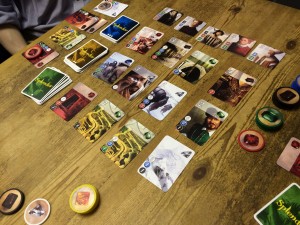 Splendor is a light, fast game of constant, small decisions. Overall, it’s a race to be the first player to score 15 Victory Points (VPs) by buying development cards using the 5 different coloured currencies (gems).
Splendor is a light, fast game of constant, small decisions. Overall, it’s a race to be the first player to score 15 Victory Points (VPs) by buying development cards using the 5 different coloured currencies (gems).
Each development card is a colour and each card shows its cost as well as how many VPs it is worth. Each card you purchase gives a permanent reduction on your future purchases; for example, a card costing 2 red gems and 3 green gems would only cost 2 red and 1 green if a player had already bought 2 green cards. As a result, players’ purchasing power increases as the game unfolds.
The game mechanic of discounting future purchases means that every card you buy is potentially useful and means each player has a slightly different view of the game because the costs of the cards on display become different for each player. Also, whilst gaining VPs is slow to start, with as players purchase the cheap (bottom row) cards usually worth no VPs, the game accelerates as players’ purchasing power increases and they can more regularly buy the expensive (top row) cards worth higher amounts of VPs. (Players can also score VPs by gaining noble tiles which are awarded as soon as a player has bought enough different coloured cards as shown on the tiles.) Read the rest of this entry »
Tags: board game news, Board Games, board gaming, SdJ, Space Cowboys, Spiel des Jahres, Splendor
Posted in Board Game Review, Board Games, Splendor | No Comments »
Posted by James (admin) on 21st May 2014
 The Spiel des Jahres nominations were announced this week. I have added a page for the SdJ with the details of the games as well as links to reviews of the games: SdJ 2014 page.
The Spiel des Jahres nominations were announced this week. I have added a page for the SdJ with the details of the games as well as links to reviews of the games: SdJ 2014 page.
The winners will be announced on July 14th.
Tags: Amerigo, board game news, Board Games, board gaming, Camel Up, Concept, Concordia, Istanbul, Rokoko, Russian Railroads, Spiel des Jahres, Splendor
Posted in Amerigo, Board Games, Camel Up, Concept, Concordia, Istanbul, Rokoko, Russian Railroads, Splendor | No Comments »
Posted by James (admin) on 20th May 2014
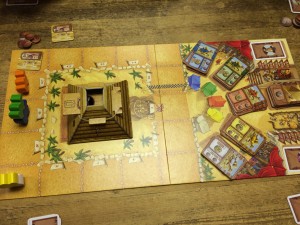 Camel Up is a simple game so it is surprising how much interaction there is and how lively it can be. During the game, camels move around a simple circuit; however, players do not own a specific camel as you may expect. Instead, players take actions which can move the camels as well as try to predict which camel will win the current round, as well as the overall race. The winner is the player with the most money (Egyptian Pounds, or EPs) at the end of the game.
Camel Up is a simple game so it is surprising how much interaction there is and how lively it can be. During the game, camels move around a simple circuit; however, players do not own a specific camel as you may expect. Instead, players take actions which can move the camels as well as try to predict which camel will win the current round, as well as the overall race. The winner is the player with the most money (Egyptian Pounds, or EPs) at the end of the game.
Players take turns by performing one of 4 actions which are:
1. Move a camel
The player drops 1 dice out of the pyramid and moves the matching coloured camel that number of spaces forwards along the track. (There are 5 dice – one for each camel each with values 1 to 3 – more about the pyramid later.) If camels are moved to space occupied by camels they are stacked on top of those already there. When camels move, they carry any other camels already on top of them along with them too. This action earns the player 1 EP. (The dice only get placed back in the pyramid after all 5 have come out which and this ends the round.)
2. Place/Move their desert tile on the race track
This tile earns 1 EP for its owner each time a camel lands on it, plus it moves that camel forwards 1 space if the tile is oasis side-up, or backwards 1 space if the tile is mirage side-up. Read the rest of this entry »
Tags: board game news, Board Games, board gaming, Camel Up, Eggertspiele, Pegasus Spiele, SdJ, Spiel des Jahres
Posted in Board Game Review, Board Games, Camel Up | 2 Comments »
Posted by James (admin) on 19th August 2013
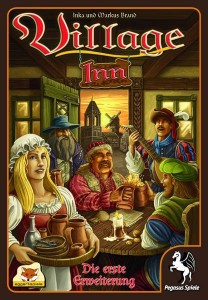
I really like Village as a game – it has you juggling lots of things at once without enough time or resources to do everything; you have to think about the other players who may take the actions/resources you want before you do so you have to prioritise what you take first and maybe alter your plans on the fly if someone has now taken something you were going to; and, players sometimes kill off their villagers on purpose so they can grab their points scoring positions in the village’s journal and by doing so means you have to watch out for the game ending sooner than you think or want. This makes a very entertaining game and I was glad it deservedly won the Spiel des Jahres last year. (The following assumes you know about the Village base game – if not, you can read my review of it here.)
As I liked the main game, I was pleased to hear there would be an expansion. However, I have realised over the years that the majority of expansions (especially for non-narrative games) end up adding more noise than gameplay – some friends and I worked out recently that we usually buy expansions because we’d like to see extra variety, but then more often end up playing the base game without the expansion because it’s usually tighter. So, into which of these categories was Village’s expansion (called Village Inn) going to fall? Read the rest of this entry »
Tags: board game news, Board Games, board gaming, Pegasus Spiele, SdJ, Spiel des Jahres, Village, Village Inn
Posted in Board Game Review, Board Games, Village, Village Inn | No Comments »
Posted by James (admin) on 13th June 2013
 The Palaces of Carrara first caught my attention because it’s a Eurogame by veterans Wolfgang Kramer and Michael Kiesling (Tikal, Tikal II, Asara). Also, the Palaces of Carrara has been nominated for the 2013 Spiel des Jahres Kennerspiel.
The Palaces of Carrara first caught my attention because it’s a Eurogame by veterans Wolfgang Kramer and Michael Kiesling (Tikal, Tikal II, Asara). Also, the Palaces of Carrara has been nominated for the 2013 Spiel des Jahres Kennerspiel.
Players buy coloured marble which they use to build buildings in the 6 cities. The player with the most victory points (VPs) at the end of the game is the winner. This may sound very ordinary, but there are several clever game mechanics that combine really well and deliver a tight and tense game.
On their turn, a player can either buy marble, build a building, or score.
Buying Marble
On the board is a rotating disc (split into 6 segments). Around the disc are 6 sets of prices for the different marble colours – white is most expensive, then yellow, then red, and so on. When buying marble, the player turns the wheel one section clockwise and draws marble blocks from the bag to bring the total on the wheel up to 11 (placing new blocks in the most expensive segment). The player can then buy any number of marble blocks but only from one single segment of the wheel. The costs are marked next to each segment and these get cheaper (even free) as blocks progress around the wheel. Read the rest of this entry »
Tags: Asara, board game news, Board Games, board gaming, Hans im Glück, Michael Kiesling, SdJ, Spiel des Jahres, The Palaces of Carrara, Tikal, Tikal II, Wolfgang Kramer, Z-Man Games
Posted in Board Game Review, Board Games, The Palaces of Carrara | No Comments »
Posted by James (admin) on 6th June 2013
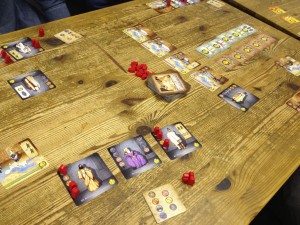 Augustus is one of this year’s nominees for the Spiel des Jahres (the largest board games award). It is designed by Paolo Mori who designed Libertalia and (one of my favourite games) Vasco de Gama. In fact, Paolo seems to be designing more and more at the moment.
Augustus is one of this year’s nominees for the Spiel des Jahres (the largest board games award). It is designed by Paolo Mori who designed Libertalia and (one of my favourite games) Vasco de Gama. In fact, Paolo seems to be designing more and more at the moment.
Players always have 3 objective cards and each can be completed by placing one of their legions (meeples) onto each of an objective’s symbols (sword, shield, chariot, etc.) Each turn, one player (the town crier) randomly draws one symbol from the bag. Then, every player can place one of their legions onto a matching symbol if they have a vacant one on one of their objectives – the placed legion can be from their supply, or they can move a legion which is already placed on an objective. So, if a sword symbol is drawn a player can place a legion from their supply, or from another objective, onto an empty sword icon.
There is a known mixture of symbols in the bag and there are more of some symbols than others, i.e. 6 swords, 5 shields, 4 chariots, etc. Therefore, whilst it’s a random draw, some symbols are more likely to be drawn than others. There are also 2 wild (joker) symbols in the bag – when one of these is drawn, players can place a legion on any one symbol, plus all of the previously drawn symbols are put back in the bag, and the town crier moves on to the next player. Read the rest of this entry »
Tags: Augustus, board game news, Board Games, board gaming, Hurrican, Paolo Mori, SdJ, Spiel des Jahres
Posted in Augustus, Board Game Review, Board Games | No Comments »
Posted by James (admin) on 1st September 2012
K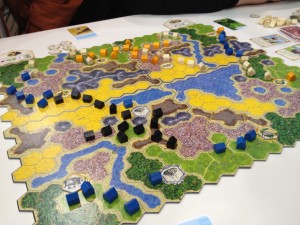 ingdom Builder is designed by the designer of Dominion and went on to win the coveted Spiel des Jahres award 2012. The game is relatively simple. Players score points at the end of the game based on where they have built their buildings based on criteria specified by 3 Kingdom Builder cards (randomly selected from 10). The board is created using 4 sections in any combination (randomly selected from 8).
ingdom Builder is designed by the designer of Dominion and went on to win the coveted Spiel des Jahres award 2012. The game is relatively simple. Players score points at the end of the game based on where they have built their buildings based on criteria specified by 3 Kingdom Builder cards (randomly selected from 10). The board is created using 4 sections in any combination (randomly selected from 8).
On their turn, a player has just one terrain card and they must place 3 of their buildings on unoccupied spaces on the board that match that terrain type. Buildings must be placed next to any of the player’s existing buildings, if possible; otherwise, they can be placed on any hexes of the matching terrain. If the player places any of their buildings next to one of the special locations on the board, they get to take one of the matching special action tiles.
As well as the mandatory action, players can use any special actions they have collected which allow a player to do things like moving buildings and building an extra buildings. The special actions can each be used once per turn. Read the rest of this entry »
Tags: board game news, Board Games, board gaming, Kingdom Builder, Spiel des Jahres
Posted in Board Game Review, Board Games, Kingdom Builder | No Comments »
 The winners of the Spiel des Jahres and the Kennerspiel des Jahres were announced yesterday. The winners were Camel Up and Istanbul. It’s always interesting to try and work out the winners because I know what I like the most (and would vote for) is definitely not the same as what I think will be voted for by the jury, because the SdJ awards are for a more general German game-playing audience (and not a more serious gamer audience).
The winners of the Spiel des Jahres and the Kennerspiel des Jahres were announced yesterday. The winners were Camel Up and Istanbul. It’s always interesting to try and work out the winners because I know what I like the most (and would vote for) is definitely not the same as what I think will be voted for by the jury, because the SdJ awards are for a more general German game-playing audience (and not a more serious gamer audience).

 Rokoko is a euro-game about preparing for the ball at the Royal Palace. This may sound pretty light-weight but, do not be fooled, this is a euro-game with a lot of moving parts to work out, balance and combine – so it’s a game for gamers. It’s one of the games nominated for
Rokoko is a euro-game about preparing for the ball at the Royal Palace. This may sound pretty light-weight but, do not be fooled, this is a euro-game with a lot of moving parts to work out, balance and combine – so it’s a game for gamers. It’s one of the games nominated for 



 The Palaces of Carrara first caught my attention because it’s a Eurogame by veterans Wolfgang Kramer and Michael Kiesling (Tikal,
The Palaces of Carrara first caught my attention because it’s a Eurogame by veterans Wolfgang Kramer and Michael Kiesling (Tikal,  Augustus is one of this year’s nominees for the Spiel des Jahres (the largest board games award). It is designed by Paolo Mori who designed Libertalia and (one of my favourite games) Vasco de Gama. In fact, Paolo seems to be designing more and more at the moment.
Augustus is one of this year’s nominees for the Spiel des Jahres (the largest board games award). It is designed by Paolo Mori who designed Libertalia and (one of my favourite games) Vasco de Gama. In fact, Paolo seems to be designing more and more at the moment.